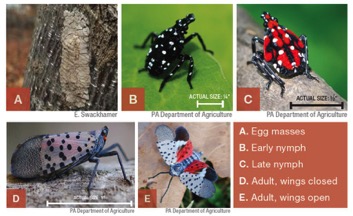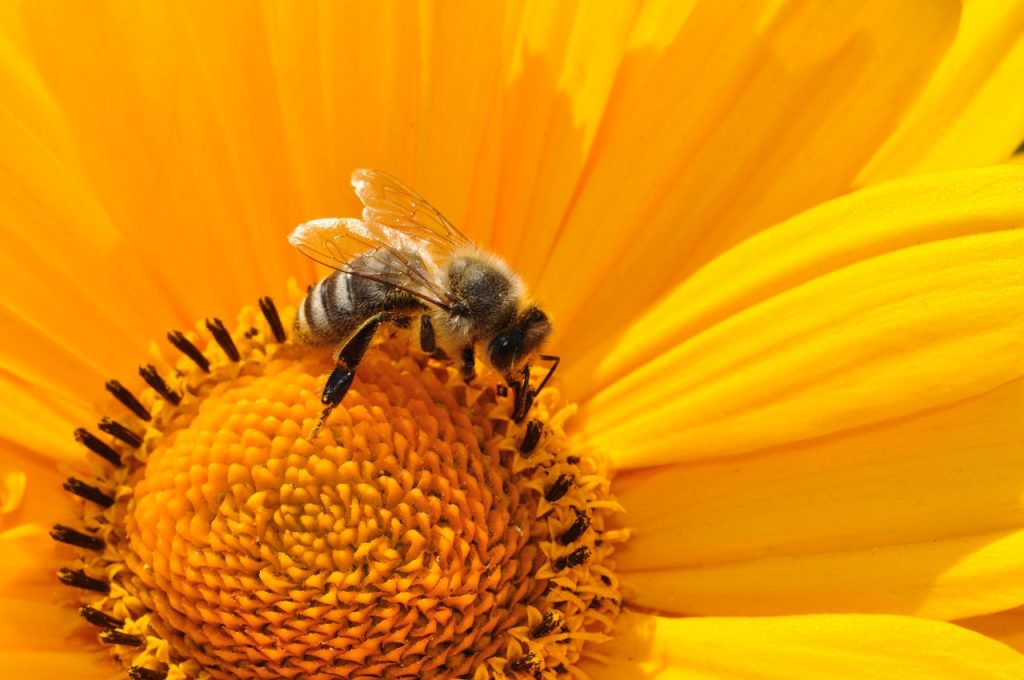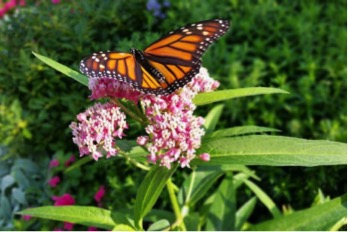
Have you heard of our Spotted Lanternfly infestation? Read on for very important information.
Spotted Lanternfly (SLF) is an invasive insect pest from Southeast Asia. It was first discovered in Berks County, PA in 2014 and quickly spread throughout the Northeast. SLF is threatening vineyards, orchards, vegetable crops and your ornamental plants, trees and veggie garden. If not contained, SLF could cause an economic loss to our state’s economy of at least $324 million each year, according to a study by Penn State University.
SLFs not only adversely affect crops, plants and trees, they produce a sticky substance called honeydew. You will not want honeydew on clothing, hair, pet fur, patio furniture, car or your kid’s swing.
Our county–as well as twenty-five surrounding counties–is under quarantine in an effort to stop or slow the spread of SLF. Pennsylvania Department of Agriculture requests homeowners check their property and vehicles for egg masses, nymphs and adults. All sightings should be reported to the Pennsylvania Department of Agriculture. Reports within quarantined areas are registered in a database for USDA and Pennsylvania Department of Agriculture. The database is used to help determine properties for treatment.
Penn State University is working with the Pennsylvania Department of Agriculture to contain the threat. Researchers have found what may be a solution. Two naturally occurring fungi found in forest soil, Batkoa major and Beauveria bassiana, appear to kill SLF nymphs. Research is ongoing, however. In the meantime, we need to help. To find out how, read this.
The host tree for SLF is Tree of Heaven, a very invasive tree that has spread throughout the United States. Remember the book, A Tree Grows in Brooklin? That’s Tree of Heaven. If you find one on your property, it must be removed. But you can’t just cut it down. Read this to find out how to identify it and what to do.
I’m hearing about extensive SLF sightings all over Media. My own experience began last fall when I saw one SLF moth on my kitchen window screen. This May, I discovered (gasp) multiple Tree of Heaven saplings in the wooded area of my property. An arborist from a tree company I consulted discovered the sixty-foot tall parent tree on the extreme edge of my property. I use a dust buster every morning to capture first, second, third, and now fourth SLF instars, which are all over the saplings. I also found instars on wild grapevines in my yard. A conservative estimate is about 500 captures. I dump the instars into a bucket of soapy water, where they quickly die. This is not how I prefer to spend my mornings, but it has to be done. Otherwise, September would be a nightmare of SLF moths.
Another effective method of control, used as a direct spray, is Safer insecticidal soap. The soap is harmless to other insects. Neem oil, on the other hand, is highly toxic to other insects. Do not use Neem! Given the insect apocalypse that is happening now, we need to protect them, not kill them. We especially need to protect our pollinators (bees, butterflies, moths, flies, beetles, friendly wasps).

Don’t want to spray? There are other ways to help SLFs exit from your life. Fly swatters work well for the adult lanterfly moths. If you miss the first time, don’t give up. Adults jump well the first time, but not as well the second time. If you follow the insect, you will be successful on the second or third try.
If you don’t want to use a fly swatter, try a zapper. Zap-It is a rechargable bug zapper. The first zap stops them from flying. The second zap kills them. The zapper has an LED Light if you are so inclined to zap in the dark.
Plant milkweed! Lanternflies are attracted to Common Milkweed (Asclepias syriaca). They don’t know it’s poisonous, so it will be their last meal. As a bonus, common milkweed can help save the Monarch butterfly from extinction, since they need it to survive.

Photo credit: Mary Lundeen, Penn State Master Gardener Dauphin County
Now that you’re informed, please go outside and check your property!
“We need everyone to protect their properties, communities, and the Commonwealth from this invasive insect that has the potential to change our landscape and quality of life.” PA Department of Agriculture

Leave a Reply